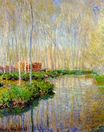Клод Моне - Маннпорт, вид с востока 1885
 |
 |
 |
 |
 |
 |
 |

Маннпорт, вид с востока 1885
65x81см холст/масло
Philadelphia Museum of Art
The image is only being used for informational and educational purposes
<< Previous G a l l e r y Next >>
Masterpieces from the Philadelphia Museum of Art:
Impressionism and Modern Art
Like Eugène Boudin, Monet visited Étretat in search of striking natural scenery and sites where he could witness the effects of light on the sea and the chalk limestone cliffs. Because the landscape of the resort town was so well known, Monet sought unique views, climbing over steep cliffs and looking at familiar motifs from unusual angles. The present painting was begun in 1885, when Monet visited Étretat with his family at the end of the season. He painted tirelessly, beginning fifty-one canvases and working at several different sites a day in order to take best advantage of the light. This view is southwest of the beach, looking toward an archway known as the Manne-Porte, with the base of a tall, narrow rock formation called the Needle visible inside the arch. The cliff-top perspective gives a dramatic, slightly dizzying view down onto the water, accentuated by the absence of a horizon line, which is lost in the hazy overcast light that has blurred the distinction between water and sky. Monet concentrated his most painterly work in the foreground, where dynamic crisscrossing brushstrokes animate the sea and thickly applied ridges of white paint outline the waves crashing on rocks and shore.
Jennifer A. Thompson, from Masterpieces from the Philadelphia Museum of Art: Impressionism and Modern Art (2007), p. 70.